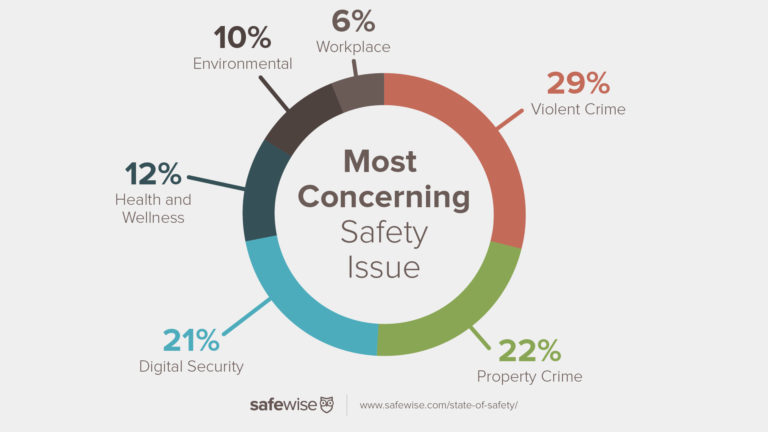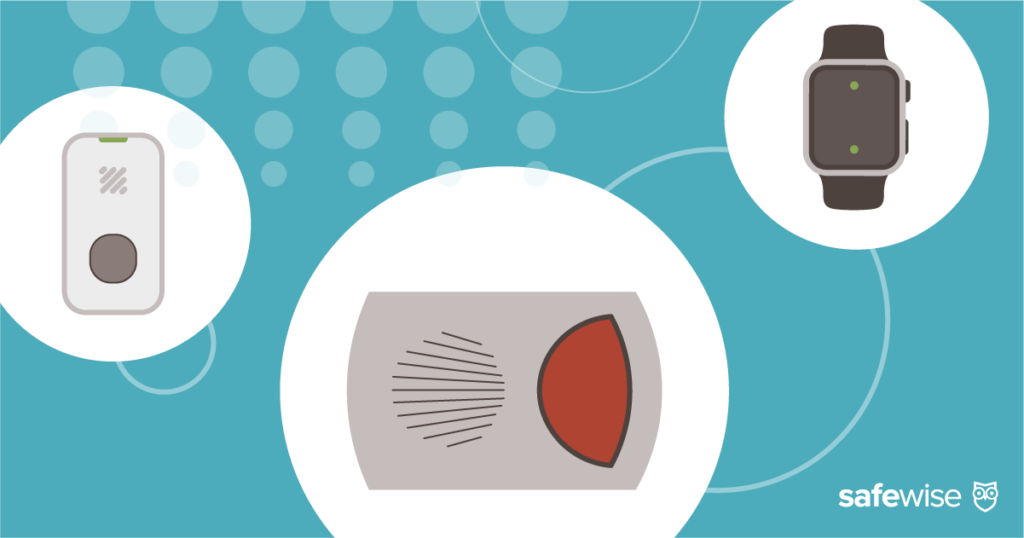This spring we launched a first-of-its-kind report about the safety concerns of Americans. Here are some insights into what we discovered. Find out what keeps Americans up at night—and how realistic those worries are.
SafeWise Releases First-Ever State of Safety Report
For over 11 years, SafeWise experts have conducted independent research and testing to create unbiased, human reviews. Learn how we test and review.
Bad news seems unavoidable these days, and the constant barrage of information about everything from natural disasters to the latest mass shooting gives us plenty of reasons to feel concerned for our safety and the safety of the ones we love.
At SafeWise, we report on crime statistics and trends and recommend the best ways to steer clear of trouble. But we wanted to dig deeper into the American psyche to see what people are really worried about when it comes to crime and safety.
That desire gave birth to the first-ever State of Safety study. We polled 5,000 Americans—100 from every state—to get a snapshot of what gives people palpitations on a daily basis. Here’s an overview of what we discovered.
Sign up for our free weekly newsletter to get the best safety news, product info, and deals.
By signing up, you agree to our Terms and Conditions and Privacy Policy.
Yes, People Are Concerned—But Not as Concerned as We Thought
Over half of Americans worry about their safety on a daily basis, 58% to be exact. While that’s a high number, we expected it to be higher.
When you think about the flipside, you’ve got 42% of Americans that are pretty relaxed about their personal safety. And that makes sense when you look at how many Americans have actually experienced a safety issue. The most-experienced issues are digital security (39%), property crime (38%), and environmental security (32%). With no issue experienced by more than 39% of the people we surveyed, it’s easier to see how 42% of the country can take a more lackadaisical attitude to safety.
What People Are Worrying About:
“I'm most concerned about terrorism/massive assaults and injuries because I live in an urban city with high profile events that have been targeted by terrorists in the past. These same events would also provide similar settings for mass shootings or other violent crimes.”
—State of Safety respondent
The folks afflicted with the most worry include households with children, women, and people living in urban areas. That didn’t surprise us, but we were shocked by how much weight some of those groups carried.
Although only 36% of the people we talked to had children in the home, their levels of concern for every safety issue were between 10 and 16 percentage points higher than people in households without kids.
Women were more concerned than men in every issue except digital security—there’s a difference of just one percentage point (60% of men showed high concern for digital safety compared to 59% of women).

When It Comes to Safety, Perception Doesn’t Always Match Reality
It’s amazing the difference a few words can make. When we showed people a list of the six safety issues we explored—violent crime, property crime, digital security, health and wellness, environmental safety, and workplace safety—and asked them to rank them in order from the most worrisome to the least, violent crime was named most often.
But when we asked them to look at each issue individually and rate their level of concern from one (not concerned at all) to seven (highest concern), violent crime fell to third place.
What People Are Worrying About:
“I do everything online (shop, pay bills, and connect with friends) and every day I hear about some large company being hacked. I do not want my data to end up in the hands of criminals.”
—State of Safety respondent
Violent Crime Isn’t the Biggest, Baddest Wolf After All
- Although violent crime was ranked the number one security concern by 29% of respondents, it’s the least-experienced crime.
- 10% reported a violent crime issue in the past year (the lowest number of any safety issue).
- 24% reported a digital security issue in the past year.
- 19% reported an environmental security issue in the past year.
- Violent crime had the lowest level of personal experience when broken out state by state. Montana reported 0% having a violent crime issue in the past year.
- Environmental safety had the highest level of personal experience when broken out state by state. Florida had 32% report an environmental issue in the past year.
- When it comes to experiencing a safety issue ever, digital security, property crime, and environmental safety all had more than 30%—and violent crime was the least-experienced across the nation at 22%.
- Environmental safety was the second-least worrying issue, with just 10% ranking it number one. But it was the third-most experienced issue.
A Pinch of Prevention Is Worth a Pound of Worry
Folks who had precautions in place like car and homeowners insurance, were less worried about crimes like theft—probably because they have some help on the way if they have something stolen.
Similarly, 80% of the people we talked to believe they are protected when it comes to identity theft and hacking. But more people experienced a digital crime in the past year than any other type of safety issue.
What People Are Worrying About:
“Because [violent crime] doesn't happen on a regular basis, it makes it scary...you don't know when or where it could take place or if it will be someone else or you. The crimes in the news and all over the world are horrifying. It makes me feel unsafe.”
—State of Safety respondent
How to Manage Your Fears and Make Your Home and Community Safer
We all want to believe we can do things to make our lives safer, and for the most part that’s true. But the headlines that create the most worry and anxiety—wildfires, the polar vortex, flooding, and mass shootings—can be difficult to prepare for.
While it’s smart to stock up on emergency supplies and disaster kits, those can get washed away in an unexpected spring deluge. But that doesn’t mean you have to spend time stressing about things you can’t control. Instead, we recommend managing exposure to the types of news and stories that get your fear centers on high alert.
- Limit your news intake.
- Block feeds (and people) on social media that are prone to fear-mongering.
- Balance scary news consumption with positive, feel-good stories.
- Sign up for daily inspiration emails or feeds.
- Look at the cold, hard facts—your odds of ending up in a natural disaster or mass shooting are pretty minimal.
Stop flooding your inbox with headlines and scary news—those only add to fear and anxiety. Unsubscribe from fear-mongering newsletters and sign up for a daily dose of inspiration or laughter.
Once you’ve got your steady stream of scary news under control, you can take the next steps—make your life feel (and actually be) safer.
- Be aware of your surroundings—in the neighborhood, at work or school, and around town.
- Get to know your neighbors.
- Lock your doors and windows at home and in your car.
- Invest in personal security like an alarm, whistle, or pepper spray.
- If you have a security system for your home or vehicle, make sure to arm it.
- Add security devices like cameras, sensors, or an alarm.
- Use a neighborhood app like the Ring Neighbors app to know what’s going on in your neck of the woods.
What safety concerns nag at you the most? Let us know in the comments and share this post with your friends and neighbors to see if your fears align with state and national results.
Recent Articles



